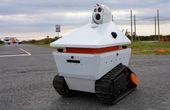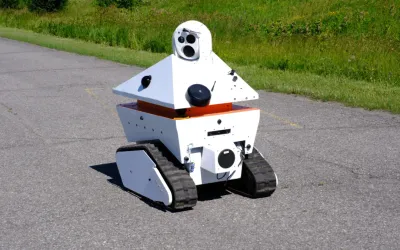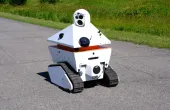AgileX Bunker Mini
A small-sized tracked-UGV by AgileX features compact and simplified modular structure with 30°climbing grade and 115mm max obstacle height suitable for small and narrow terrain.
Technical Specifications
| Dimensions | 660L x 281W x 584H mm |
| Height | 65.5mm |
| Track width | 100mm |
| Weight | 54.8kg |
| Rated Travelling Load | 35kg |
| Speed | 0~1.5m/s |
| Communication | CAN |
| Operating Temp | -20℃~60℃ |
| IP Rating | IP67 |
| Power Drive | Left and Right Independent Drive |
| Track Differential Steering | |
| Rated torque | 17Nm |
| Max Obstacle Height | 115mm |
| Climbing Grade | 30°(No load) |
| Min Turning Radius | 0m (In-situ Rotation) |
| Motors | 2 x 250W Brushless Servo Motor |
| Encoder | 1024 Line Magnetic Encoder |
| Battery | 24V 30Ah Lithium Battery |
| Charge Time | 3-4h |
| Charger | AC220V Charger |
| External Power Supply | 24V/15A |
Overview
Exhibiting functions on the ground even without human presence, Unmanned Ground Vehicles (UGVs) are paving the way for remotely controlled vehicles. They show profound applications requiring operators a safe distance from potential dangers, like detonation, exploration, and rescue. In missions that take place in tight and small terrain, the need for a compact UGV arises. Meanwhile, the best option for rugged terrain is locomotion through tracks—although they are less efficient and slower, vibrate more, and require more mechanical complexity.
The small-size BUNKER MINI is an off-road tracked mobile robot chassis designed for narrow and small environments. It has an IP67 rating, which denotes an effective operation in the sand, water, and dust. It works wonders for industry developers in platforms needing robotic applications for waterway mapping and surveying, security inspection, unconventional photographing, mineral inspection, and many more.
Design
BUNKER MINI achieves a compact design with its simplified modular structure that only spans 660W x 584H x 281L mm. It weighs 54.8kg and has a track width of 100mm to carry a 35-kg maximum traveling payload. The IP67 rating also denotes the capability of wading through deep waters.
The Controller Area Network (CAN) technology allows for controlling BUNKER MINI remotely. The 24V/30Ah battery powers the vehicle for a maximum travel speed of 1.5m/s. It has a 24V/15A power supply and requires an AC220V independent charger to recharge within 3-4 hours.
Hardware
BUNKER MINI has a track differential steering drive-type with a left-and-right independent drive feature. It has a rated torque of 17Nm, with its two 250W brushless servo motors and magnetic encoder of 1024 line type.
The forward tilt track feature allows BUNKER to climb slopes and steps at a maximum obstacle height of 115mm and a climbing grade of 30° without payload. It rotates in place (In-situ Rotation) with a 0mm turning radius.
Expansion
Integrating third-party sensors and IMU provides customization for operating BUNKER MINI in advanced operations. The aluminum T-slot rails on top is a standardized mounting solution, which is convenient for mounting external equipment, sensors, and one preconfigured R&D navigation kit.
It has reserve standard profile holes, supporting quick construction of the top loads for industrial control, IMU, routing, camera, and sensing. BUNKER MINI can be loaded with any kind of pick-and-place manipulator and any inspection equipment.
BUNKER MINI can support access to more advanced automatic driving systems, like Python, GAZEBO Simulation, and ROS1. It interfaces with external devices through CAN, while secondary developments are possible with the C++ and ROS packages inclusion.
Packages
The fully integrated AgileX R&D solution, designed for robotics research and development, has a full suite of sensors supporting navigation, indoor SLAM, and vision-based application. It also features an Nvidia Jetson Nano computer with Linux Ubuntu 18.04 & ROS Melodic pre-installed software. Other devices include an Intel RealSense depth camera, WiFi module, LCD, and EAI G4 LiDAR.
The R&D Pro package is similar to the standard kit, except for its Nvidia Xavier computer and not to mention the Velodyne Puck LiDAR.
A hardware-software solution enabling autonomous navigation is the AgileX Autopilot Kit, which also provides path planning and avoids obstacles without needing preloaded maps. It comes with various sensors, devices, and computers, including high-precision LiDAR, Pixhawk 4 controller, binocular and depth cameras, and RTK GPS antenna.
AgileX AutoKit, based upon the Autoware open-source software, is a full-stack driving development and education kit at a cost-effective price. It gives a powerful autonomous driving sensor, which integrates seamlessly into the robot platform. An 8-core 32GB RAM computer, LCD, Robotsense 16 channel LiDAR, and a USB-to-CAN module are some of the sensors, devices, and computers that come with the AutoWare Kit.
Software
The open-source Robot Operating System (ROS) is a middleware suite for robot software development. It is not an OS but a software framework collection that provides various functions for a heterogeneous cluster. The cluster includes low-level device control, hardware abstraction, package management, and others.
The Controller Area Network (CAN bus) allows communication between microcontrollers and devices without a host computer. While it is initially built for multiplex electrical wiring in automobiles for saving copper, this message-based protocol is also applicable in a variety of contexts. AgileX CAN bus protocol allows users to communicate over CAN.









